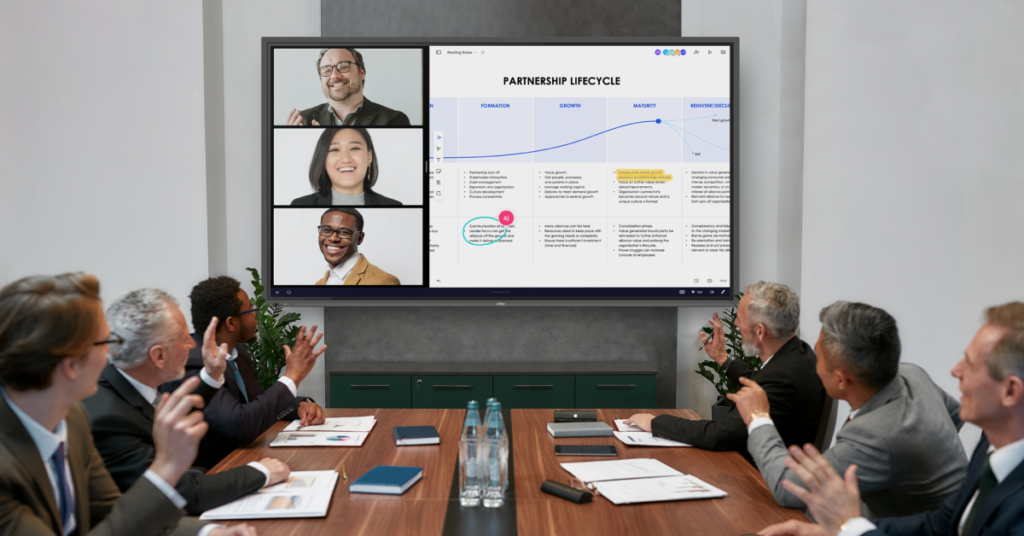As new workplaces take shape, many employees are heading back to work or settling into hybrid models. For some employees, though, it’s business as usual from home. Creating a strong team connection can be one of the most difficult things for these remote employees.
Amid all the back-to-work excitement, it’s not surprising that forever-remote employees are experiencing some FOMO. According to one study, 53% of remote workers are worried about being left out of in-person team meetings and other in-office activities.
Being a remote employee doesn’t have to be stressful! In fact, many employers are upgrading workplaces to be more inclusive of remote workers. If you’re a remote employee starting to feel like you’re missing out, here are five ways to connect with your team.
1. Go Camera On, Always
Yes, going camera on all the time can sometimes feel exhausting. One of the easiest ways to include yourself in the office is to keep your camera on during video meetings.
A faceless Zoom profile picture makes it hard for your team to pick up things such as body language. As tricky as it can be to communicate body language via video conferencing, there are a variety of nonverbal behaviors that are critical for relationship building.
For example, when your camera is on, your team can get a sense for your mood through basic mannerisms. This creates a sense of openness, which can help build trust and rapport with your team.
Keeping your camera on also shows you’re ready to go — just like your teammates in the office. Being camera ready not only conveys confidence but also demonstrates responsibility. While you don’t have to say goodbye to your favorite pair of stretchy pants, it’s important to show you are professionally dressed, focused and prepared for the video meeting.
2. Build a Team Connection with Casual Check-Ins

Casual office conversations often spur the best ideas. Even when they don’t, spontaneous interactions are important for teams to build relationships with each other. Working remotely doesn’t mean you have to miss out on casual catch-ups.
Make time throughout your week or month to schedule 15-minute check-ins with your teammates. Keep the conversations positive and light during these sessions. Don’t be afraid to share some personal information, such as weekend plans or updates on pets or children.
If scheduled check-ins aren’t spontaneous enough for you, consider using a service like Spark Collaboration to facilitate truly random connections. The service randomly pairs employees who have never met or want to get to know each other better for short, coffee shop-style conversations.
If the mere thought of small talk makes you cringe, you might be surprised at how good you feel after your first week of check-ins. A recent survey featured in Harvard Business Review found that on days workers made more small talk than usual, they experienced more positive emotions and a stronger team connection. Further research even suggests that spontaneous conversations can improve creativity, innovation and performance among individuals.
Short sessions with your teammates can also help you get to know your coworkers on a more personal level. According to Gallup, the foundation for strong teams is built at the individual level. Developing personal connections with coworkers allows you to see their strengths and get a sense for what they’re passionate about beyond the workplace. When teams can more effectively relate to one another, it boosts group connectivity, creates space for positive dialog and helps keep potential conflicts at bay.
3. Ask to be Included in Everything
Unplanned meetings and impromptu huddles are more likely to occur among teams working in person. These events can often lead to remote employees feeling disconnected and left out.
A recent study confirmed that nearly 60% of remote workers struggle with missing out on important information because it was communicated in person. This common struggle is also one of the top contributors of stress and anxiety for remote employees.
To prevent these feelings before they start, ask to be included in everything. By speaking up and requesting invites to every meeting, huddle and call, you’re letting your teammates know exactly how you feel. Additionally, nobody has to wonder whether they are bothering you with a meeting invite on short notice.
If you have concerns about feeling overwhelmed by the volume of potential meeting invites, be sure to set your working hours, especially if you work in a different time zone. Setting and communicating boundaries ensures that everyone knows if you’re within working hours, you’d like to be included.
If you’re new to remote work, setting boundaries is a great way to prepare yourself mentally and physically for the new changes you’ll experience as a remote employee.
4. Don’t Be Afraid to Over-communicate

It’s a fact: remote work can be lonely and isolating. Next to collaboration and communication, loneliness is one of the top challenges facing remote employees. There’s no reason to suffer in silence.
While it’s easy to pop into a coworker’s office or crash a cubicle when you have a question, it’s not as simple when you’re a remote employee.
If you have questions or you need additional clarity from a coworker, don’t hesitate to reach out. Create a stronger team connection by familiarizing yourself and making use of the digital tools available to you for communication. Slack and rocket.chat are two great communication tools to help teams stay connected in the workplace.
Video conferencing is another great way to level up your communication, especially when it comes to transparency. We’ve all found ourselves trying to decode body language or break down confusing emails. Instead of spending your time analyzing, ask your coworker to hop on a quick Zoom call to clarify questions.
As a remote employee, embrace the practice of over-communicating. However, be mindful to make sure you’re following some basic rules for effective communication. Here are a few examples.
Use the correct channels.
Many workplaces use project management software in addition to email and instant messaging. Be sure you know the system your company uses for communication. If you keep questions and conversation in Slack, should you save project-related status updates for your project management tool?
Be clear and concise.
When you’re sending a long Slack message or a big email, make sure you take time to slow down and give it a thorough proofread. If you like to type stream-of-consciousness style, consider reviewing before you hit send.
Consider your tone.
Things can get lost in translation and misinterpreted — it happens. Depending on the style of your organization, a well-placed emoji might be an acceptable way to convey tone. If not, take a moment to consider the person who is reading your message and how they might interpret it. If you feel like things could get misconstrued, don’t hesitate to pick up the phone or start a video chat.
5. Embrace Flexibility
Flexibility, after all, is one of the greatest benefits of remote work. As much as you enjoy the benefits of increased flexibility in your day to day, make sure you’re extending the same sentiment to the members of your team. Creating a stronger team connection must run both ways.
Here are a few ways to lean into greater flexibility:
- Recognize that unplanned meetings are a natural part of working in person. When they pop up unexpectedly on your calendar, embrace the spontaneity and join with a positive attitude.
- Understand that your team may develop inside jokes or occasionally reach a decision without you. Give your coworkers the benefit of the doubt and assume they have positive intentions.
- If you find yourself getting left out of video meetings, make a point to speak up and advocate for yourself. Ask for a more favorable camera position or request digital versions of documents being shared or discussed during a meeting.
- Above all, cultivate meaningful relationships with your team. When you trust each other, it’s easier to go with the flow when challenges arise.
Team Connection Made Possible with Vibe

Speaking of flexibility, Vibe Smart Whiteboards are designed to supercharge collaboration and bring teams closer.
One of the biggest advantages is the Vibe Canvas, which can be accessed from any device, anywhere. As a remote employee, you can seamlessly collaborate alongside your coworkers in the office, even across time zones.
{{< blog/cta-download-new content="Product Comparison Report" extra="false">}}
With an infinite Canvas, you can save and export sessions, which means you never have to worry about accidentally erasing critical information or wasting time digitizing notes post-meeting.
Vibe also integrates with a variety of third-party apps such as project management tools and video-conferencing software. When a great idea arises from an impromptu brainstorm, it’s easy to send tasks directly to your project management tool of choice.
Want to learn more about how to connect remotely with a Vibe Smart Whiteboard? Check out this video to see how easy it is to collaborate with remote team members.
